How a Coal Mining Family in Lancashire Merged With a Stone Quarrying Family from Rastrick
This is the story of a connection between a Lancashire coal mine owning family and a Rastrick stone quarry owning family.
We will discover how two brothers who were successful stone quarry owners in Rastrick, died at relatively young ages and left their business in their will to a surviving sister. She then married a member of a coal mine owning family from Clayton, Lancashire who came to live in Rastrick and successfully operated stone quarries in this area. They owned Longroyd House and paid for a stained glass widow at St. Matthews Church in memory of one of their children but the family fortune was short-lived.
JAMES HOLROYD – MASON & STONE MERCHANT
We start the story with James Holroyd, the son of John Holroyd who was born at Rastrick in 1775 and was baptised at the old St. Matthew’s chapel in the village on the 28th May that same year. He started his working life as a stone mason but eventually worked his way up to become the leaseholder and quarry master at his own stone mines in Rastrick and in Milnsbridge, Huddersfield. It was a hard life for many small quarry owners, working in harsh conditions, sometimes with little reward but James, in partnership with his brother John, reaped the rewards of hard work. They took a gamble by leasing land at Badger Hill and Crowtrees which paid off and by extracting many tonnes of fine quality sandstone, they soon became respected businessmen within the Rastrick area.
James married Sarah Sutcliffe, a spinster from Elland, at Halifax on the 28th August 1808. We know that Sarah was affectionately known as Sally as that was the name inscribed upon her gravestone when she passed away on the 2nd February 1856, aged 72 years.
In the 1817 list of Freeholders and Copyholders within Rastrick, James and his younger brother John are included on the list for that year, dated the 22nd August 1817. In the following year, John Holroyd appears in the Poor Rate Assessment book dated 2nd April 1818. This is an assessment for the relief of the poor in the Township of Rastrick and from it, we can see that Jonathan Schofield was the Overseer whilst John Holroyd, Thomas Greenwood, Thomas Aspinall and Ebenezer Clegg were the appointed Churchwardens. In a book entitled Statistics of the English Poor Rate, written by Frederick Purdy in 1860, he says that, ‘the parish is served by Overseers whose appointment is compulsory and unpaid; they are not generally distinguished for their intelligence.’ That said, all of the Church Wardens and the Overseer were of sufficient intelligence to be able to sign their names in the assessment book, not an ability that many had in 1818.
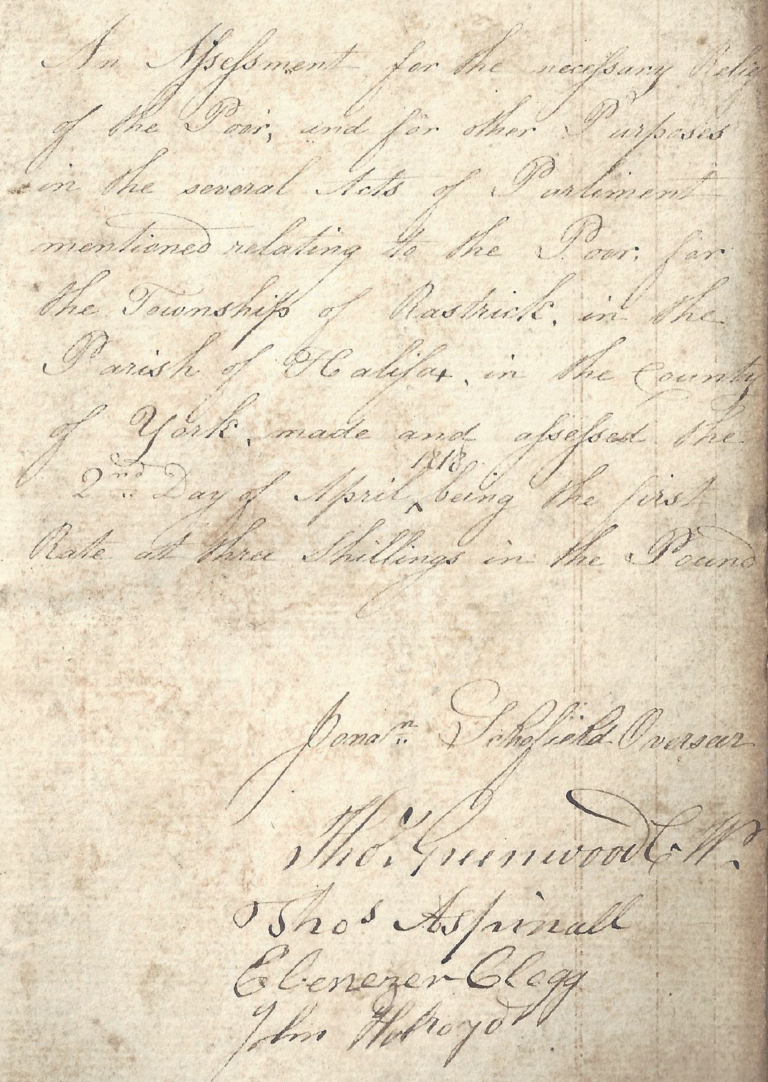
It was these people who were responsible for the collection of the Poor Rate, a local tax which was used to support the needy within the village and was a forerunner to our present council tax. John and James Holroyd are shown in the book as occupying land held by William Armitage. John Holroyd also occupies land from Armitage in his own name but it doesn’t give details of what or where the land is though the fact that the owner was Armitage, we can be almost certain that it was in the Crowtrees area of Rastrick. John is also shown as the proprietor of some different plots of land, one which he occupied himself, whilst three others plots were occupied by John Battye, Jeremiah Brierley and Mahlam Cooper.
In 1823, John & James Holroyd were renting what was almost certainly quarrying land at Southage from Thomas Thornhill Esq. for £18-3s-4d per year. The Poor Law tax for that year added an additional £2-14s-6d making a total of £20-17s-10d, which was no mean amount in those days. By the year 1825, John & James Holroyd were shown as joint owners of property at Closes, Rastrick which they were still leasing to the above Messrs. Battye, Brierley and Cooper but they must have acquired more property in the ensuing seven years as by 1825 they were renting property to additional men by the names of George Bottomley, Gideon Dickinson, John Moore and James Smith. The brothers are also shown as occupying land at Crowtrees belonging to Mrs. Margaret Armitage who had inherited it following the death of her husband, the above mentioned William Armitage and also from Thomas Thornhill Esq. at a rent of £23-10s-4d.

The Holroyd’s were residing at Chapel Street, Rastrick in 1825 and during this year, they were both included on the Juror List for Rastrick where their occupations were simply recorded as masons. In 1829, James was once again recorded on the Juror List for Rastrick by virtue of holding freehold land whilst the 1832 electoral register for Rastrick portrays James as a ‘freehold and copyhold owner of land and houses at Little Woodhouse’. This is the same area as the previously mentioned ‘Closes’, an area of Rastrick near to the many stone quarries in the Longroyd and Lillands district of the township. The Holroyd brothers were both shown as residing at Chapel Street because John (1778-1844) remained a bachelor for all of his life and resided with James and his family. In 1835, John was again named on the Juror’s List which once more showed his home address at Chapel Street. John retired a relatively wealthy man and on his daughter’s marriage certificate in 1849, his occupation is described as a ‘gentleman’ despite having died five years before. This was a title mainly reserved for the upper classes of society, demonstrating that they didn’t need to work in order to live a comfortable lifestyle.
What is rather strange is that the two brothers are named together as lessees of the quarries at Southage and Badger Hill and appear to have been business partners yet the company was known as James Holroyd & Sons, Stone Merchants, with no mention of John. When James died on the 2nd May 1839, five years before his brother John, the business was taken over by James’ two sons George and John who were both employed by the company. James was buried at St. Matthew’s, Rastrick in plot B32 two days after his death. His death was announced in the Leeds Mercury dated 4th May 1839. The photo below shows the gravestone of James Holroyd.
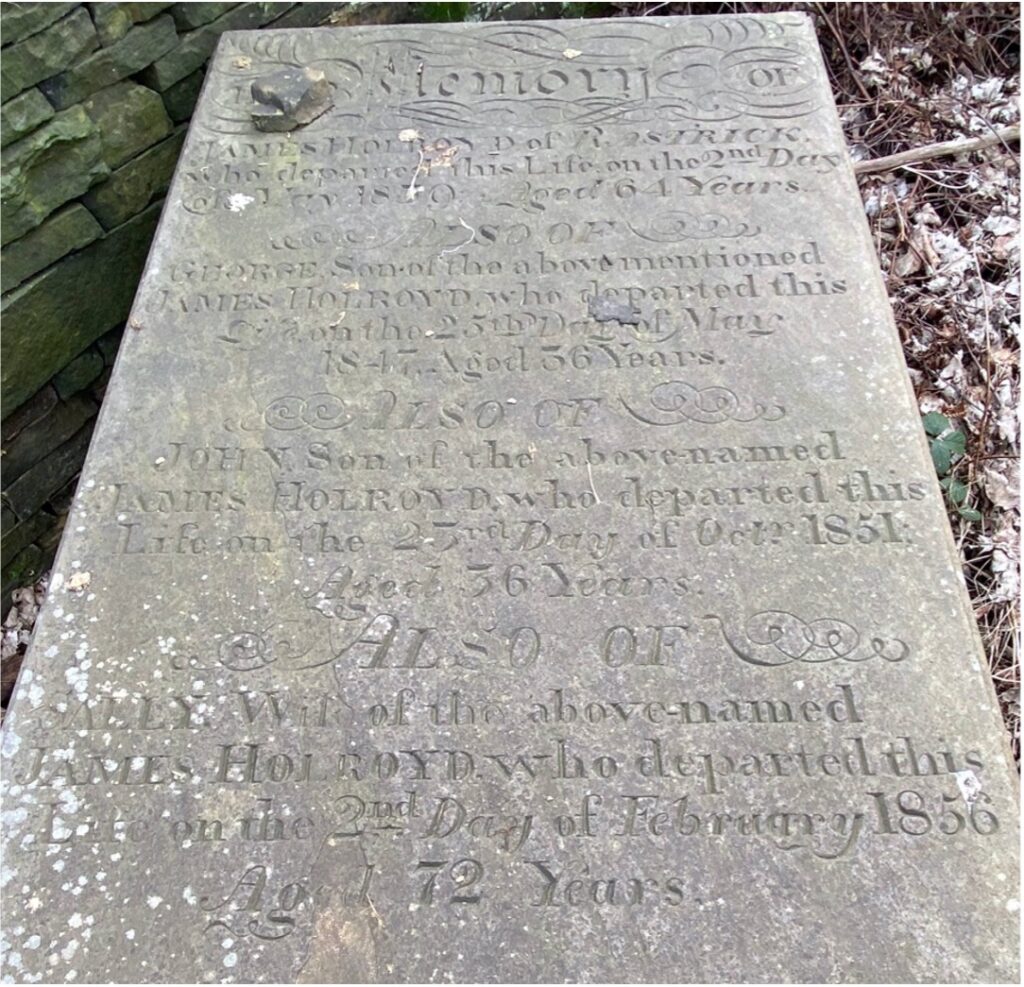
CHILDREN OF JAMES HOLROYD & SARAH SUTCLIFFE
James and Sarah Holroyd had four children, three sons and one daughter.
1. The eldest child was William Holroyd who was born on the 13th January 1809 but he died on the 28th June 1810 at the age of just 17 months.
2. George Holroyd (1811-1847) is shown as the son of James Holroyd, a mason from Rastrick, on his baptism record dated the 14th April 1811 at St. Matthew’s, Rastrick. He was born on the 5th February that same year. In the 1841 census, George was a stone merchant residing at Chapel Street (now Church St.) with his mother and brother John. He didn’t marry and when he died in 1847 it meant that his brother John had to run the family business alone. George was buried at St. Matthew’s in plot B31
3. John Holroyd (1816-1851) was the third son and was baptised at St. Matthew’s on the 13th August 1815. He too was a stone merchant in the 1841 census, residing with his brother George as mentioned above. He was also employed as a Surveyor of the Highways by the Rastrick Local Board and in 1840 he showed his opposition to the Leeds & Manchester Railway Co. who had blocked the road (now Gooder Lane) by bisecting it with their new railway line. The railway company had reneged on their original promise to put a level crossing over the rails so that traffic from the Rastrick quarries could still have direct access through to the canal basin in Brighouse. John tore down the railway company wall which had been placed across the road and filled in a ditch beside the lines before tipping earth on the actual rails. He was prosecuted for causing danger to railway passengers. His efforts proved successful however, as the railway company eventually gave in and built the current road bridge at the end of Railway Street. Following the death of his brother George in 1847, John continued to run the stone quarrying business which still retained the name of James Holroyd & Son, Stone Merchants. John died in 1851 and in his will, partly shown below, he left the business to his sister Sarah and her husband Thomas Bradbury. John was buried at St. Matthew’s in the same plot as his brother. Their father is laid beside the brothers in plot B32.

4. Sarah Holroyd (1818-1882) was born on the 5th July 1818 and baptised at St. Matthew’s on the 16th August that same year. We will discuss Sarah in more detail in the next chapter.
SARAH HOLROYD & THOMAS BRADBURY
On the 26th December 1849, Sarah Holroyd married Thomas Bradbury, a coal mine proprietor from Openshaw, Manchester. She and her husband were the beneficiaries of her brother, John Holroyd’s will, following his death in 1851.

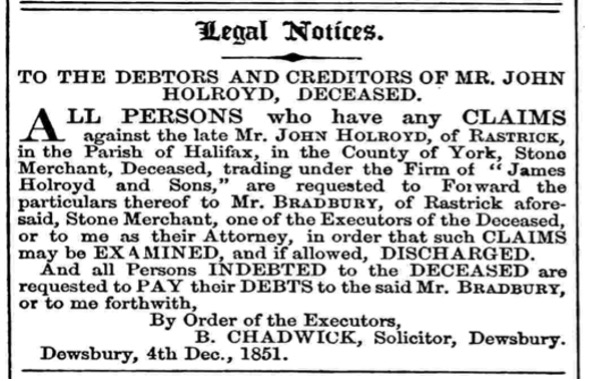
Thomas Bradbury’s family were involved in coal mines at Clayton, Lancashire and at Biddulph, Staffordshire. Following the death of Sarah’s brother, John Holroyd, Thomas needed to tackle the financial affairs of the James Holroyd Stone merchant company, as can be seen in the attached newspaper advert (left) where he asked people to settle any debt owed to Holroyd or, if anyone had any claims against him, to submit them in order that they could be discharged.
In the 1851 electoral registers, Thomas Bradbury was still shown as residing in Openshaw, where he and Sarah went to live following their marriage, but he was also shown as the owner of houses and land at Little Woodhouse, Rastrick. This must have been property that Thomas and Sarah inherited upon the death of John Holroyd. Little Woodhouse was close to several stone excavation sites so it was presumably the location of the early Holroyd quarries. By 1852, Thomas and Sarah had relocated to Rastrick to concentrate on the stone mining business. They were residing at Crowtrees (presumably, Crowtrees House) but in 1853, the couple purchased Longroyd House which had many acres of land containing large quantities of good quality sandstone beds.
The sons of James Holroyd had passed away by this time and this not only allowed Thomas Bradbury to continue the James Holroyd & Sons business under a local manager but it also allowed other merchants to lease the various quarries on his land whilst he sat back and reaped the rewards of other people’s labours. Thomas became involved in local politics and was once described as ‘a moving spirit in Rastrick political and social life.’ The Bradbury’s purchased a further residential property in Southport, away from the industrial grime of their coal and stone production businesses. In 1861, Thomas Bradbury was recorded on the census as being at his home in Longroyd, Rastrick. At the same time, he was also shown at his coastal residence in North Meols, Southport where he was described as a civil engineer and stone merchant employing eighty men. Obviously he could not have been in two places at the same time so where he actually was during the night of the 1861 census on the 7th April is anyone’s guess.
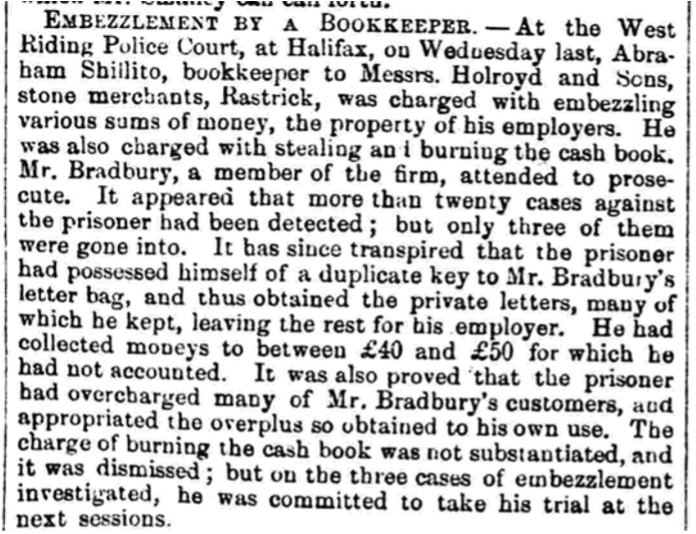
The following year, the Huddersfield Chronicle dated 22nd November 1862 reported that the Holroyd & Sons company bookkeeper, Abraham Shillito had been charged with embezzlement of company funds. After obtaining a duplicate key to Thomas Bradbury’s letter bag, Shillito removed some letters and then kept money that he should have included in the company accounts. He went on to use the money for his own use and was found guilty of the offence. He was sentenced to nine months imprisonment at the West Riding Sessions in December that year.
By 1869, Thomas and Sarah Bradbury had become established in the Rastrick community after moving into Longroyd House some sixteen years previously. The Huddersfield Chronicle of the 31st July 1869 shows that Thomas was also a philanthropic gentleman who supported local organisations such as providing new uniforms for the Brighouse Subscription Brass Band.
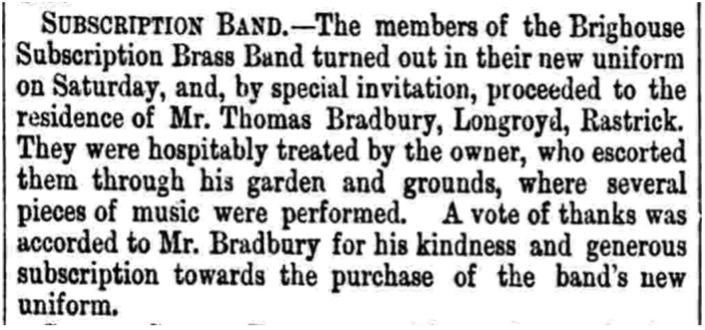
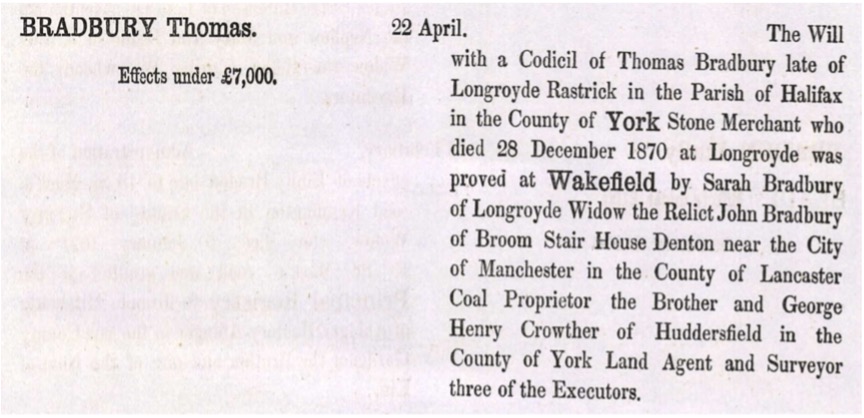
Thomas died on the 31st December 1870 at Longroyd House and was buried in the family crypt in the churchyard at St. Matthew’s, Rastrick. In his Will, with a Codicil (a later amendment), he left effects under £7,000. His brother John was named as one of the people to whom the Will was proved. His wife Sarah continued to live at Longroyd until she sold the property to the local silk spinner, John Cheetham in 1877.
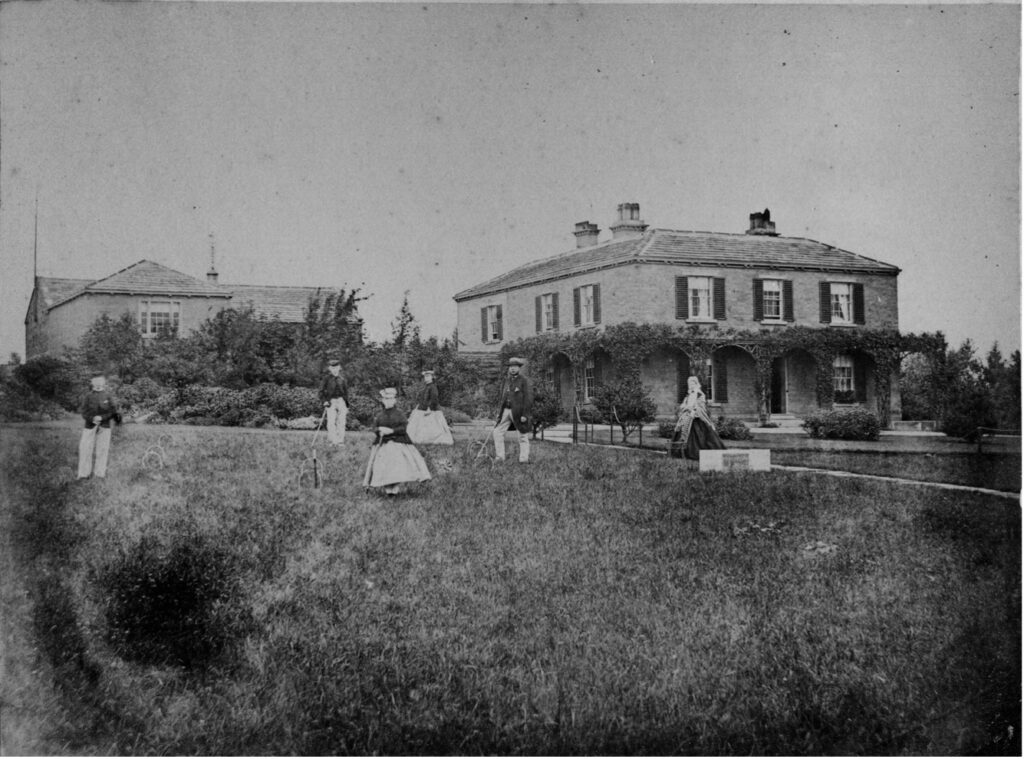
In the above photograph, kindly sent by Barbara Bradbury, it shows the Bradbury family at Longroyd. The lady on the path is Sarah and the man is her husband, Thomas Bradbury, therefore the photograph must pre-date his death in 1870. They had four surviving children, two girls and two boys so this a very early family photograph and possibly the earliest I have ever seen from Rastrick.
THE BRADBURY FAMILY EARLIER HISTORY
So what were the earlier origins of Thomas Bradbury’s family?
He was the fifth child of John and Elizabeth Bradbury of Clayton, Manchester. John Bradbury was born in 1790 and originated from Glossop, Derbyshire. He married Elizabeth Wood at Manchester on the 6th September 1813. John trained as a bookkeeper and found employment with John Thornely of Clayton House who owned the nearby Clayton Colliery. The pit had been established in the 1790’s but in the 1820’s, John Bradbury, Charles Barrett and Silas Leigh bought the colliery lease. In 1831, John Bradbury and Silas Leigh also bought land at Biddulph, Staffordshire where they established the Bradley Green Colliery. Several of John’s sons became involved in the business and the Bradbury & Leigh partnership later bought the leases of further coal mines at Clayton, Broom Stair at Haughton and the nearby Hyde Colliery.
In the early 1840’s, Charles Barrett gave up his partnership in the Clayton Colliery leaving John Bradbury and Silas Leigh as the sole owners. In the 1841 census, John gave his occupation as ‘Coal Master and Agent’ and was shown living with his wife Elizabeth and five of their children at Clayton but sadly, Elizabeth died in 1842. John quickly found another wife and married Hannah Shawcross in Manchester on the 26th January 1843.

John & Elizabeth had been blessed with no less than thirteen children who we will look at in a short while but his marriage to Hannah didn’t produce any more children. When John Bradbury died on the 24th August 1852 at the age of 62 years it meant that his coal mining empire would have to be run by some of his children.

THE CHILDREN OF JOHN BRADBURY (1790-1852) & HIS WIFE, ELIZABETH WOOD
There were nine boys and four girls and of those nine sons, five of them went into the colliery trade. They are listed overleaf but it was mainly down to two of his sons, William b. 1814 and John b. 1818, who became the main owners of the business which they continued, in partnership with Silas Leigh.
The sons of John & Elizabeth Bradbury were:-
- William Bradbury 13th August 1814 went to work at the Bradley Green Colliery in Staffordshire where he worked as a coal agent. By 1861 he is shown on the census as a colliery owner employing 90 men and 30 boys. In May 1862, William Bradbury, coal proprietor of the Bradley Green colliery at Biddulph was elected as a member of the Royal Agricultural Society of England. The Bradley Green & Black Bull Gas Company Ltd, Biddulph, was opened on the 16th December 1865 and William Bradbury was elected as the first chairman of the company whilst still the proprietor of the nearby colliery. It is almost certain that William provided the coal with which to make the gas so it was a very lucrative contract for him. There were obviously some underhand dealings going on but these were days when the term ‘conflict of interest’ was unheard of.

William died at the Eagle Hotel, Buxton, Derbyshire on 29th May 1872 and left effects valued at almost £18,000, equivalent to £2.166m in 2021. There is a memorial plaque at the church of St. Lawrence, Biddulph, to the memory of William Bradbury, pictured left.
2. John Bradbury 25th March 1818 worked at the Broom Stair pit and in 1861 was shown as a coal proprietor with a 21 year lease, employing 350 men. By 1871 the pit employed 149 men and 49 boys. At this same time, John was a Justice of the Peace in his local town. He retired to Southport where he died in 1878 at Haughton House, named after his home town. He was 60 years old. John left effects valued at £90,000, which is equivalent to £11.4m in 2021. His executors were George Edward Holroyd Bradbury of Rastrick and Joseph Clayton Bradbury of Bradley Green.
3. Thomas 1821 is mentioned above and became the husband of Sarah Holroyd of Rastrick.
4. Joseph Bradbury 1824 became a bookkeeper like his father before him. He became the colliery manager at Haughton from 1850 until his death in 1859 at the age of 35 years.
5. George Bradbury 1825 went to work in the cotton mills as an overlooker. He had a brief spell as the colliery manager at Haughton following Joseph’s death but left after a short period to become an Innkeeper. He married Hannah Shawcross in 1852 at Manchester and the couple had two sons and two daughters, none of whom worked in the family mining businesses.

6. Henry Clayton Bradbury 1828 became a colliery agent around 1850 at the Bradley Green pit in Biddulph. He went back to live in Haughton in 1856 but continued to own land and a house at Bradley Green. He died at Matlock, Derbyshire in 1906 at the age of 78 years.
7. James Bradbury 1830 had no connection with the collieries and became a chemist and druggist. He died in Manchester on the 9th August 1869 aged 39 years. He left a widow, Jane and three children, two daughters and one son named James Steel Bradbury. None of this family worked for any of the coal mining companies.
8. and 9. Benjamin and Charles Edward who didn’t live beyond infancy.
As mentioned above, following the death of their father in 1852, John Bradbury b. 1818 managed the company affairs in Clayton, Haughton and Hyde whilst William Bradbury b. 1814 lived in Biddulph, Staffordshire and ran the Bradley Green Colliery.
But this where it gets confusing and I have tried to simplify it at the end of this section.
Dealing firstly with Clayton, the photo below shows a safety lamp check from Clayton Colliery. It is believed that Clayton may have been the first ever colliery to use them. If this is proved incorrect, it was certainly one of the very early pits to do so. This meant that every miner who went underground could be accounted for after they returned to the surface. The colliery is also believed to be the first one to stop women from working underground several years before legislation banned the practice in 1842.
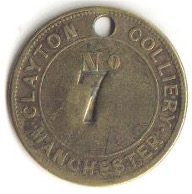
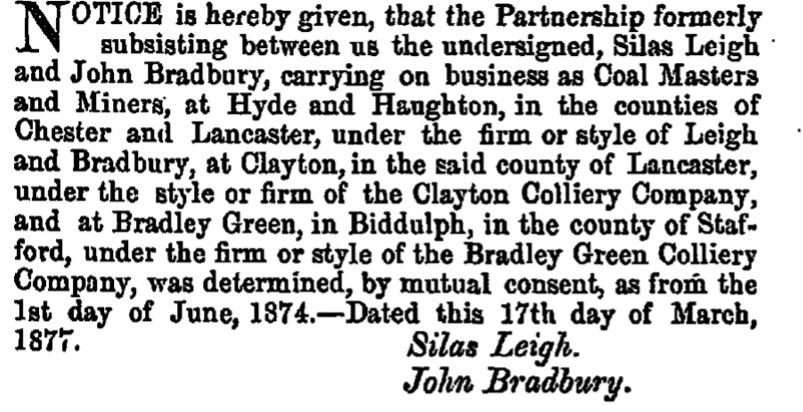
John Bradbury’s partnership with Silas Leigh at the Lancashire, Cheshire and Staffordshire collieries continued until it was dissolved in 1874 by mutual consent although the official announcement did not take place until the 17th March 1877.
The following year, 1878, Clayton Colliery was closed following the death of John Bradbury who had previously retired to Southport, leaving his nephew with the same name, to run all the businesses. The Hyde and Haughton Coal Company took over the Hyde and Broom Stair pits which survived until 1898 before closing forever. Silas Leigh had made his fortune in the silk trade and didn’t appear to take a great interest in the coal mines but obviously took handsome profits from the businesses. When he died in 1879, he left estate worth over £33m in today’s equivalent value although I suspect the majority of this was made from silk and not from coal.

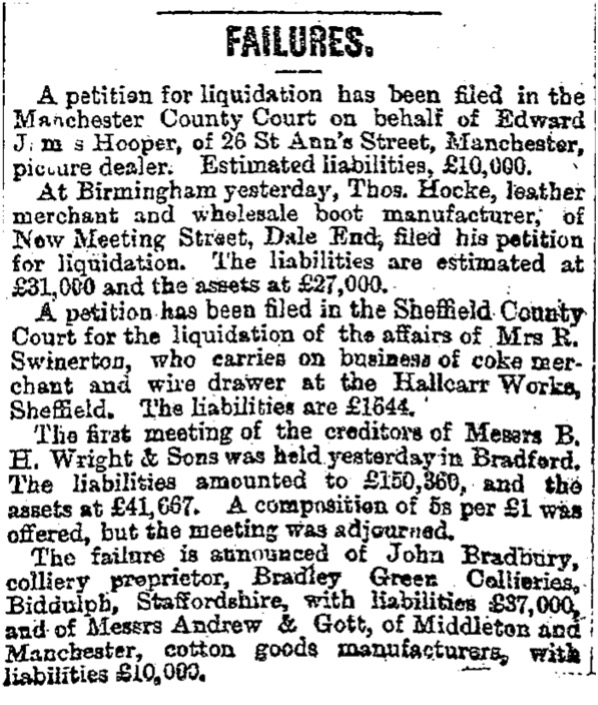
At the Bradley Green Colliery in Biddulph, William Bradley (1814-1872) had taken over the reins upon his father’s death in 1852 but when he passed away in 1872, two of his sons took over the affairs in Staffordshire. The sons were yet another John Bradbury (1842-1901) and Thomas (1847-1876). Confusingly, this meant that two different John Bradbury’s were running the various collieries whilst other brothers and nephews took on lesser management roles. When Thomas died in 1872, his probate record stated that he was a colliery proprietor at Bradley Green. His brother, John Bradbury (1842-1901) continued to work as the colliery owner at Bradley Green but this was also destined to failure and in September 1882, the newspapers reported the failure of Bradley Green Collieries with liabilities estimated at £37,000 (over £4.7m in 2021). In October 1882, after the finances had been scrutinised further, the liabilities were £28,146 of which £17,419 was secured and other disputed assets of £4,328 meant that there was no option but to liquidate the company. The collieries were taken over by Robert Heath who formed the Biddulph Valley Coal & Ironworks. John died at Biddulph in 1901.

THE SIMPLIFIED VERSION
Following the death of John Bradbury (1790-1852) his two sons took over the collieries as follows:-
John Bradbury (1818-1878) and William Bradbury (1814-1872) were the proprietors at Biddulph, Clayton, Haughton and Hyde collieries in partnership with Silas Leigh.
John ran the businesses at Clayton, Haughton and Hyde whilst William ran the Bradley Green Colliery at Biddulph.
1872 – William died leaving his brother John and Silas Leigh as the owners.
1874 – John dissolved the partnership with Silas Leigh making him the sole owner. In the meantime, William’s two sons, John (1842-1901) and Thomas (1847-1876) formed a partnership and took over the running at Biddulph.
1876 – Thomas died leaving his brother John (1842-1901) in charge. This confusingly left two different people called John Bradbury as proprietors.
1878 – John (1818-1878) died leaving John (1842-1901) as sole proprietor. Clayton was closed following floods and the Haughton and Hyde collieries were sold to the Hyde & Haughton Coal Company. This left John to concentrate his efforts at Bradley Green.
1882 – Bradley Green Colliery was liquidated after falling into financial difficulties.
1901 – John (1842-1901) died.
MEANWHILE, BACK IN RASTRICK
Following the death of Thomas Bradbury at Longroyd in 1870, the business of James Holroyd & Sons, Stone Merchants, was slowly falling into decline. The company were still receiving orders, one of which was reported in the Huddersfield Chronicle dated the 4th October 1873. The report stated that the Rastrick Local Board Surveyor had informed a meeting about work which had commenced on the pavement at Newlands, Rastrick (Gooder Lane area between the railway and St. John’s Church) and that the quote from James Holroyd & Sons had been accepted for supplying the flags. Despite similar orders, the company’s fortunes were waning mainly because most of the decent stone had been extracted from their quarry, resulting in less profitability.
The Bradbury’s appear to have closed their stone quarrying businesses in 1877, around the same time as they made the decision to sell Longroyd to a successful local textile manufacturer, John Cheetham. Ironically, the end of the Bradbury stone quarrying business in Rastrick more or less coincided with the closure of their Lancashire and Staffordshire family-owned coal mines.
Sarah Bradbury retired to the family home in North Meols nr. Southport where she died on the 21st April 1882. Her remains were brought back to Rastrick and were interred alongside those of her husband in the family vault at St. Matthew’s. Thomas and Sarah Bradbury had five children, three sons and two daughters, all of whom had ‘Holroyd’ as one of their forenames.
- The eldest child was Eleanor Holroyd Bradbury 1851 in Openshaw, Manchester where her parents went to live after their marriage in 1849. She married Henry Myott from Biddulph and emigrated to California where she died in 1923.
2. The second child was George Edward Holroyd Bradbury 27th March 1852. He started work as a clerk for the James Holroyd & Sons company but following the death of his father, he took over the role of a stone merchant in his own right. He married Mary Ann Sheffield at St. Matthew’s, Rastrick on the 10th October 1877 and they had six children between 1879 and 1895. Following the sale of Longroyd, George and his family went to live at Birken Royd, Castle Hill, Rastrick. In 1881, he was shown as a retired stone merchant at the age of 29 years. He lived his life as a gentleman of leisure at Castle Hill where he died on the 7th January 1895 leaving effects valued at £432. During his life he was an Overseer of the Poor for Halifax and according to the Leeds Mercury obituary above, he was also a former member of the Rastrick Local Board, the Rastrick School Board and the Rastrick Burial Board.

3. The third child was Frederick Holroyd Bradbury 12 November 1853. He started his working life as a surveyors clerk whilst living at Longroyd but moved to North Meols with his mother when she retired there. He married Ellen Billinge in 1882 at Ormskirk and worked as a brewer’s traveller. It appears that he returned to Rastrick and moved into the family house at Castle Hill where he died in 1910 leaving effects valued at £236-8s-8d. This appears to signal the end of residency at Castle Hill and the Bradbury descendants of George Edward Holroyd Bradbury seem to have taken on employment in various fields and the fortunes made over the previous decades appears to have been spent.
4. The fourth child was Edith Elizabeth Holroyd Bradbury b. 11th August 1855. She went to live with her mother in North Meols and married. Clement Hall of South Africa. She died in Southport on the 12th March 1909, aged 53 years
5. The fifth child was William Leonard Holroyd Bradbury 27th August 1857. He died aged 3 years on the 22nd March 1861. William’s death was obviously a time of great pain to the family and as a tribute and lasting memorial to him, Thomas and Sarah paid for a stained glass window (pictured below) at St. Matthew’s Church, Rastrick. The window depicts the nativity scene on the left and the presentation of Jesus in the Temple from St. Luke’s gospel, Ch.2, on the right. The inscription gives the child’s dates of birth and death but his name is simply inscribed ‘M.L.H. BRADBURY.’
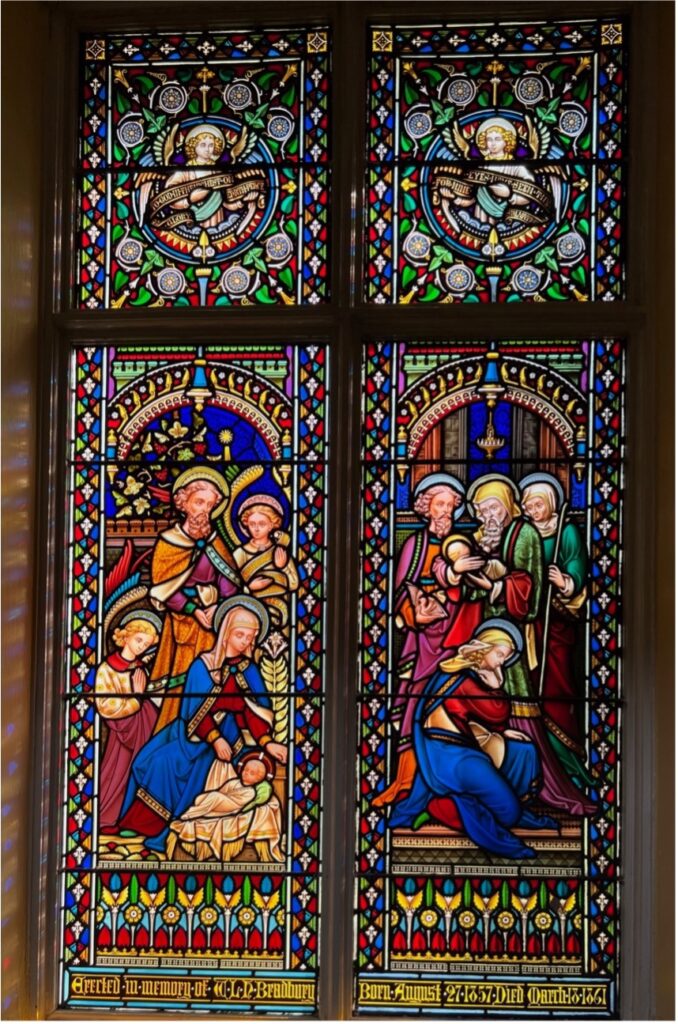
CHILDREN OF GEORGE EDWARD HOLROYD BRADBURY AND HIS WIFE, MARY ANN SHEFFIELD
We now return to the second born child of Thomas and Sarah Bradbury, who was George Edward Holroyd Bradbury. As stated above, he and his wife Mary Ann had six children, three boys and three girls. Only three of the children went on to be married, thereby reducing the potential for a large number of children within the next generation.
The eldest child, Eleanor Holroyd Bradbury was born on the 21st December 1878. She was given the same name as her father’s elder sister who was born in 1851. Eleanor married Charles John Ferguson on the 8th June 1904 at St. Matthew’s. Charles was the son of a silk spinner who lived at Castle Hill House, Rastrick, whilst Eleanor lived at Castle Hill therefore there is no doubt about where they met. At the time of Charles’ death in 1928, the couple lived at Crowtrees House, Rastrick. Ironically, this is the same house as where her grandparents, Thomas and Sarah had lived, 76 years previously. Eleanor moved to Wales after her husband’s passing and she died at Wrexham in 1962, aged 83 years.
The second child was James Herbert Bradbury, born 24th January 1881 at Rastrick. He became a worsted manufacturers clerk and married Annie Elizabeth Fisher at St. Matthews on the 12th July 1909. He fought with the Lincolnshire Regiment in the 1st World War and went on to become a mill manager in the Rastrick textile industry. He died at Rastrick in 1967 aged 86 years.
The third child was Sarah Muriel Bradbury, born 9th November 1885 at Rastrick. Sarah started her working life as a school teacher at a local council school. She didn’t marry and lived with her mother, sister Mary and brother George, both of whom also remained single throughout their lives. In 1939 she was residing with them at 15, The Square, Castle Hill, Rastrick. By this time, she had given up teaching and was an assistant secretary for a local hydraulic engineering company. She eventually retired to Whitby with George and Mary and survived them both. She died at her home at West Thorpe, Stakesby Road, Whitby on the 13th January 1981 at the age of 95 years. West Thorpe was (and still is) a residential care complex where Sarah went to live at some time after the deaths of her brother and sister.
The fourth child was George Cecil Bradbury, born 12th October 1887 at Rastrick. He was a clerk at the gasworks in 1911 and was still doing the same job in 1939 when he was living with his widowed mother and sisters at 15, The Square, Rastrick. Upon retirement, George went with his two sisters to live at Blue Bank Cottage, Sleights nr. Whitby, North Yorkshire where he died on the 20th January 1959 aged 71 years.
The fifth child was Mary Bradbury, born 21st September 1889 at Rastrick. There is no record of Mary ever having been employed and in 1939, whilst living at The Square, Rastrick with her mother and siblings, her occupation was described as ‘non paid domestic duties’ so presumably she looked after the house and her mother whilst Sarah and George went out to work. Mary is also recorded as living at Blue Bank Cottage, Sleights, North Yorkshire at the time of her death on the 4th December 1973.
The youngest child was Edward Holroyd Bradbury, born 29th January 1895 at Rastrick. Like his brother George, he was employed as clerk at the Elland-cum-Greetland Gas Company in 1911. Edward volunteered for the army at the start of the 1st World War, serving with the Prince of Wales Own (West Yorkshire) Regiment. He was wounded on the 1st April 1918 in France after receiving a gunshot wound to his chest. He was taken to the Field Hospital at Etaples, France, before being transferred to a hospital in Antwerp, Belgium. Edward was eventually sent for rehabilitation to a hospital in Coventry and after being demobbed on the 28th April 1919, he was assessed as being 50% disabled. This resulted in him being awarded a disability pension of 13s 9d per week whereupon he returned to live with his family at The Square, Rastrick.

A promissory letter from the gas company, offering Edward a position as a Junior Assistant Gas Manager had been sent to the Brighouse Labour Exchange in January 1919 and after making a recovery from his injury in Coventry, Edward accepted the position. In 1922, he married Edith Duckworth from Broughton nr. Preston and soon afterwards, he returned to Coventry with his wife where he took up a position with one of the many vehicle manufacturing companies. His sons, John Holroyd Bradbury and Michael Digby Holroyd Bradbury were born there in 1926 and 1930 respectively. They are both shown on the 1939 England and Wales Register, living with their parents at a house named ‘Brandelhow’ situated on Westwood Heath Road. Edward was shown as a ’motor bodies production controller’ on the document which also shows that he was a Special Constable with the Coventry City PoliceFollowing the outbreak of the 2nd World War later that year, Coventry was seen as a prime target for the Luftwaffe due mainly to the fact that many of the car manufacturers had been adapted to make military vehicles and aircraft for the armed forces. In 1940, Coventry was blitzed on several occasions. Over 43,000 houses were bombed, the cathedral was destroyed and the 15-acre Daimler site was turned into a raging inferno as around 150 high explosive bombs hit that target. There were also many civilian deaths and injuries.
This must have affected Edward and his family but the Westwood Heath Road area escaped relatively unscathed and many of the occupants on that road offered to re-house families that had been ’bombed out’ until more permanent housing could be found for them.
Edith Bradbury died in 1950 and was buried in Coventry but two years later, Edward re-married. His second wife was Mary Mona Greenwood, the daughter of Herbert Greenwood who was the manager of the Halifax Banking Company (later Martins and then Barclays Bank) in Thornton Square, Brighouse. Unusually for that era, Mary was a cricket coach and played the sport for Yorkshire Ladies, North of England Women and in 1937, she even represented England in two test matches against Australia. In 1939, Mary lived at a house called Fran-Ria at High Street, Brighouse but following their marriage, Edward and Mary went to live in Scarborough where their home was also given the name of Fran-Ria at 17, Peasholm Crescent.
Edward died there on the 26th May 1968 and Mary passed away at her home on the 4th April 1976 leaving effects valued at £50,893. This brings about the conclusion to the story of how a Yorkshire quarrying family became united with a Lancashire coal mining family. I would imagine that the descendants of John Holroyd Bradbury, for whom this story has been researched, will be able to add further information regarding the next generations of the Bradbury family.
The next four photographs shown below are of the Bradbury family vault in the grounds of St. Matthew’s churchyard at Rastrick, the final resting place for so many members of the family. Unfortunately, the ornate iron railings that once surrounded the grave were removed and smelted down for re-use during the 2nd World War, as part of the war effort. Young people who have been sentenced by the courts to perform community service work are often engaged in clearing up the graveyard at St. Matthews. It is an invaluable service as the grass is kept at a reasonable height, the pathways are clear and trees are regularly cut back. Unfortunately, the sawn tree branches are then dragged out of the way and are often dumped in the top corner of the graveyard, on top of the Bradbury grave. This has been pointed out to officials at the church and it is now hoped that this practise will cease.
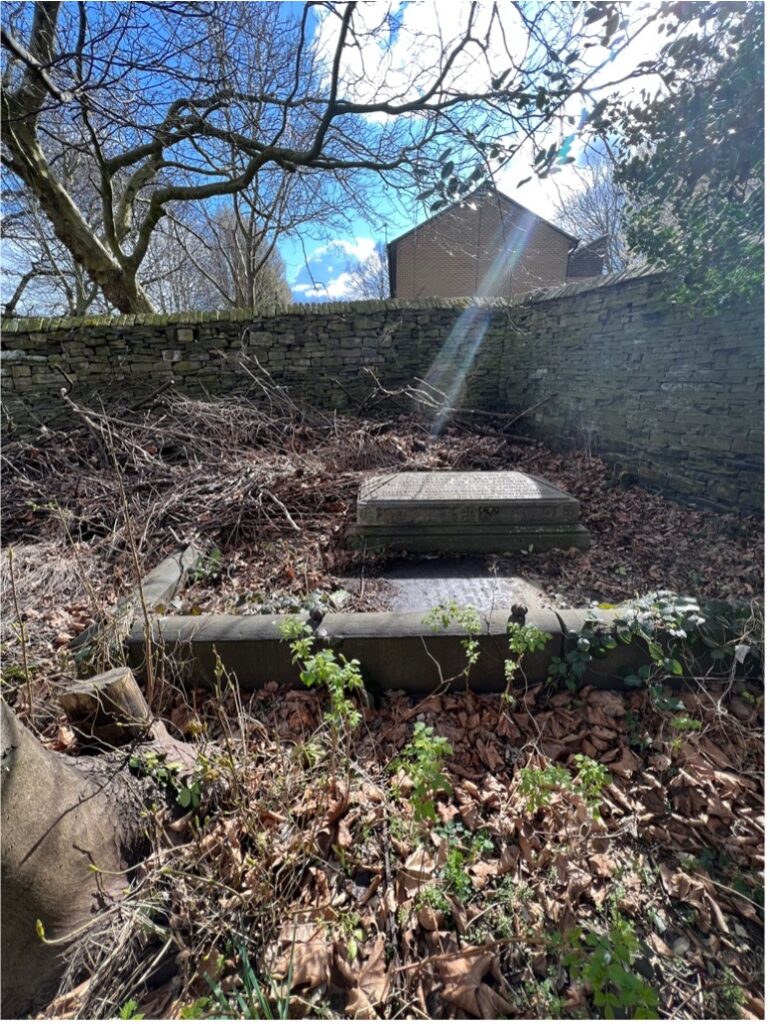

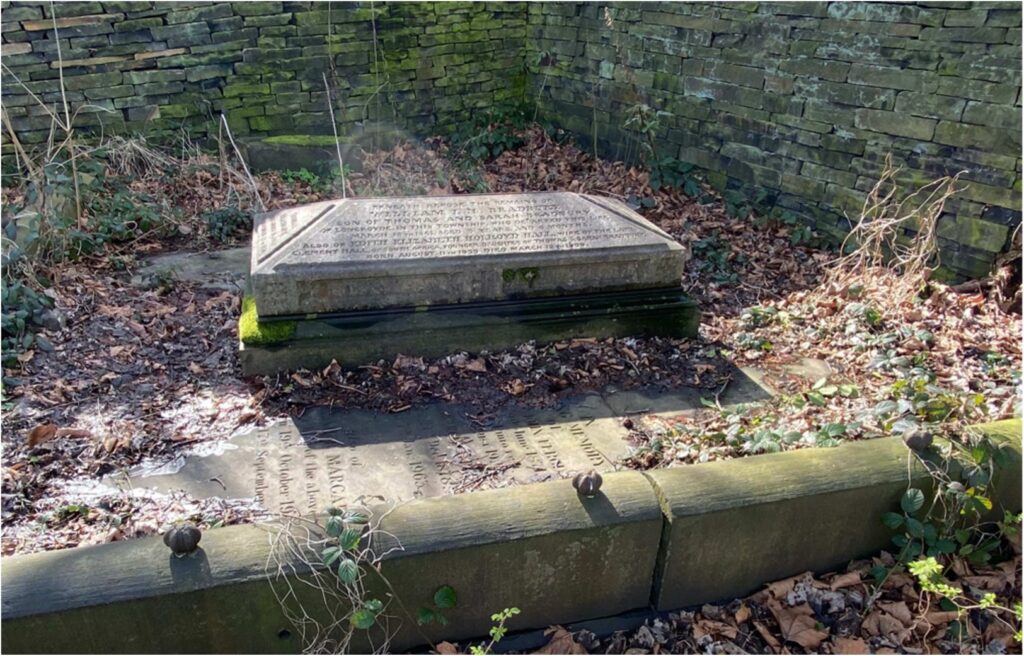
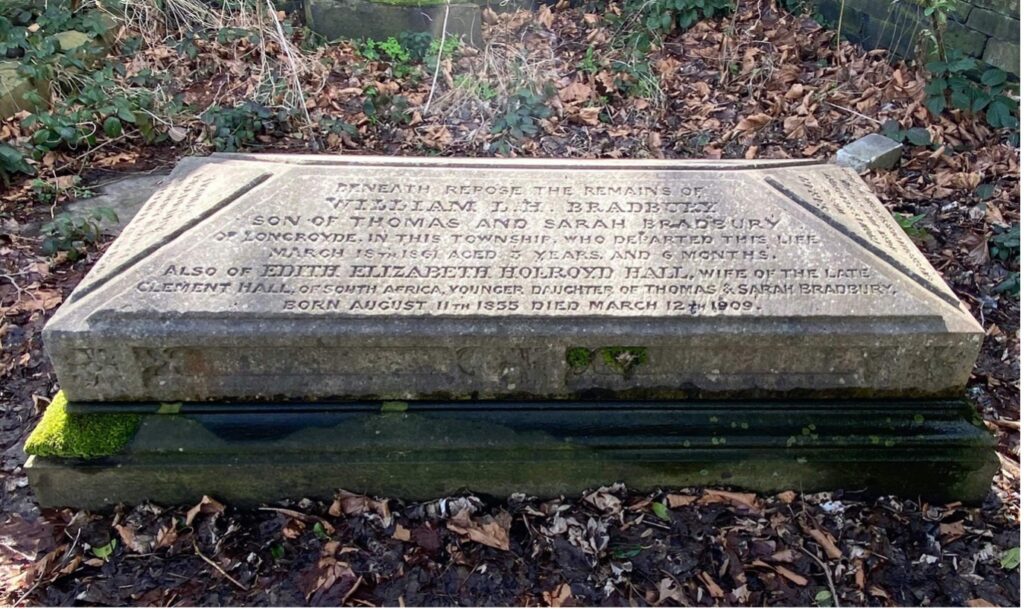
An interesting booklet was produced in 2013 by Ian Miller (author) and Adam Parsons (illustrator) entitled:
COAL, COTTON & CHEMICALS, THE INDUSTRIAL ARCHAEOLOGY OF CLAYTON.
From page 9, this booklet talks about the increasing demand for coal in the eighteenth century. Advances in technology meant that mining companies could sink shafts which allowed them to exploit the deeper coal seams. The largest of these deep mines was at Clayton Colliery, which was established in c 1790. Very little is known of the origins of the colliery other than it was owned by John Thornely of Clayton Hall but following his death in 1818, the colliery was taken over in the 1820’s by a partnership that included John Bradbury who traded as the Clayton Colliery Ltd. The partnership of Bradbury and Leigh also purchased land at Biddulph in Staffordshire in 1831 where they established the Bradley Green Colliery. They also owned collieries at Haughton, Lancashire and Hyde in Cheshire. The document gives an interesting insight into the colliery until it closed in 1878 and is well worth a read.
https://diggreatermanchester.files.wordpress.com/2018/11/gmpr09_clayton.pd